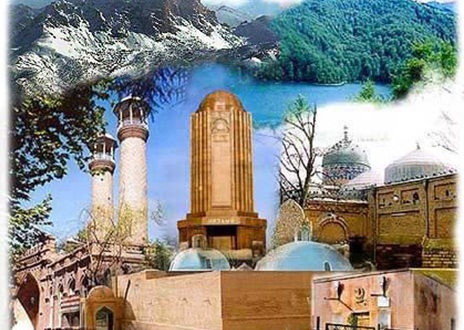Djuma Mosque
The mosque was constructed in the 12th century (1606) in the days of Shah Abbas whose name is also attributed to the mosque - the pride of Ganja. This year it has celebrated its 400th anniversary. The building was constructed under the project of the architect, the astronomer and vizier of shah Abbas - Sheikh Bahauddin the direct descendant of Nizami.
The red brick mosque is a stocky but a rather wide building. It consists from the hall for prayers divided into two rooms (for men and women) by a big screen and smaller adjacent rooms. The mosque`s windows are decorated with patterned lattices-shebeke. A long time ago a market square surrounded by shops and century old plane trees was swarming with people in front of the massive gate of the mosque. The mosque`s roof is a huge metal dome of 17 meters in diameter.
As if growing from the mosque two tall minarets crowned with observation posts tower over the complex. The minarets were restored and slightly modified in the 19th century. But all the same their original design is amazing.
It is known that Sheikh Bahauddin was a great astronomer. He used his knowledge in the mosque construction: exactly at noon the shadow falling on the western wall of the structure disappears. It has served as prayer time reminder for true believers. Even now the citizens of Ganja use the disappearing shadow to check the correctness of their watches - the accuracy is impeccable.
In the yard of the mosque is a madrasah constructed at the same time (it was demolished during the Soviet times). Today both the mosque and the madrasah have been restored and active.
Chekyak-Khamamy
Soon after the mosque was ready Sheikh Bahauddin built Chekyak-Khamamy nearby.
The bath consists of two connected halls. The big one has a pool and a fountain in the center for relaxation and the smaller - for bathing. Made of red brick the bath has two big and five smaller domes. On top of big domes are set semi-domes which worked like fans: from there aerating ducts ran inside the walls. Hot in winter, cool in summer the bath was heated by fire wood. The cellar was used for two steam boilers. The steam was fed to the halls via ceramic pipes running inside the walls and the floor. The steam circulated evenly and heated the entire building. This unique system of the 400-year-old bath worked like clockwork until 1963. And all these centuries the bath was very popular among the townspeople. The feeling that you bathe where shah Abbas spent his time gave special flavor to the procedure of bathing.
Since 2002 Chekyak-khamamy has been considered a landmark o international significance and is under protection of UNESCO.
Caravanserai
The third subsequent structure of Sheikh Bahauddin complex is Ganja caravanserai. Today the building of medieval caravanserai plays the role of the Temple of knowledge. In the end of the 20th century there was founded Ganja humanitarian college. The caravanserai is a two-storied building with 15 halls and 54 rooms. The building also hosts the museum of a poetess Mesheti Ganjevi.
More about:
















































